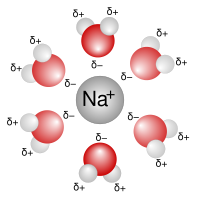
Photo from wikipedia
In this study, we compared the contributions of polar and nonpolar interactions to the solvation free energy of a solute in solvent, which is decomposed into four different terms based… Click to show full abstract
In this study, we compared the contributions of polar and nonpolar interactions to the solvation free energy of a solute in solvent, which is decomposed into four different terms based on the nature of interactions: (i) electrostatic solvation free energy term counting for the work done to move solute charges from fixed points in some reference environment to their configuration positions in solvent; (ii) solute-solvent van der Waals dispersion interactions; (iii) change on solvent-solvent interactions and solvent entropy due to reorganization of solvent around solute cavity in solvent; and (iv) compensation of electrostatic forces acting on the dielectric surface boundary between solvent and solute. We compared these contributions to each other for a data set of 573 proteins, which were prepared using CHARMM22 and AMBER force fields. In addition, we compared the calculated with experimental hydration free energies for a data set of 642 small molecules, which were prepared using the general AMBER force field. Our results indicated the significance of each term to the total solvation free energy.
Journal Title: Journal of chemical information and modeling
Year Published: 2017
Link to full text (if available)
Share on Social Media: Sign Up to like & get
recommendations!